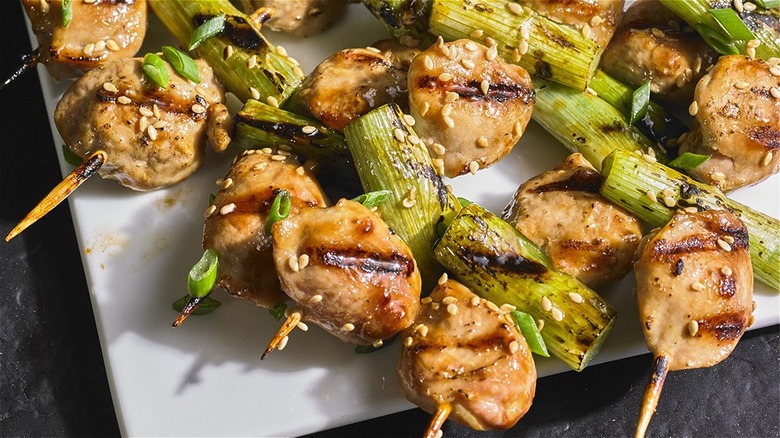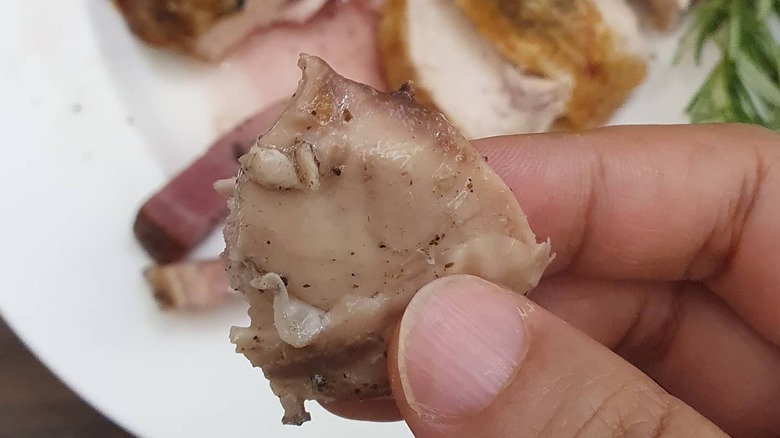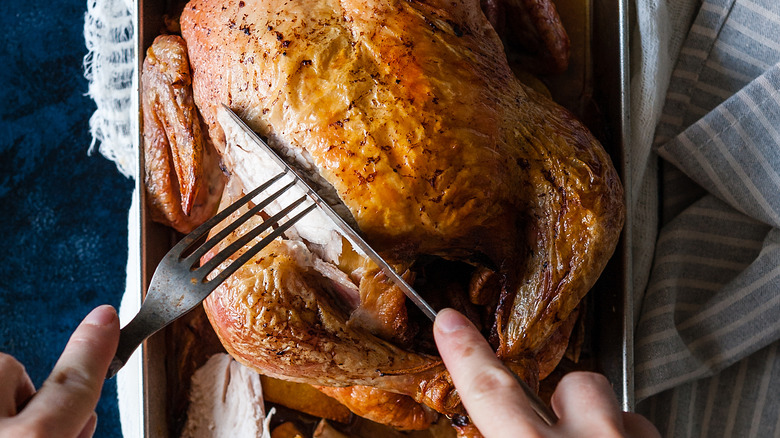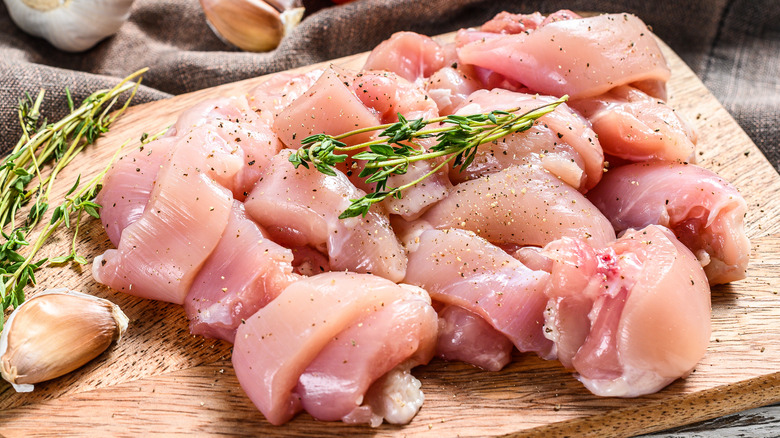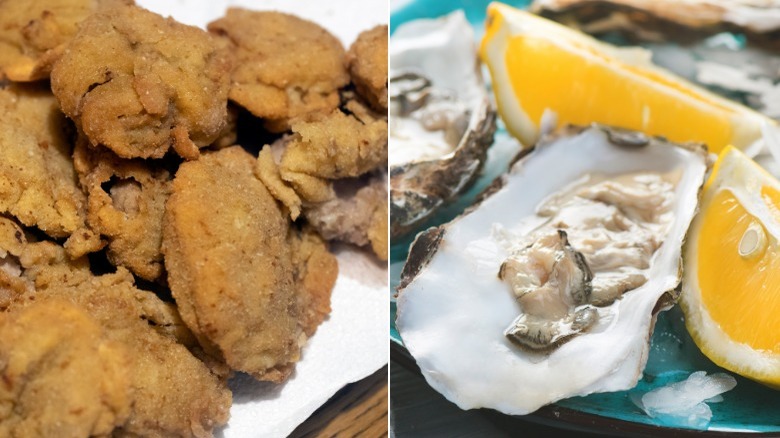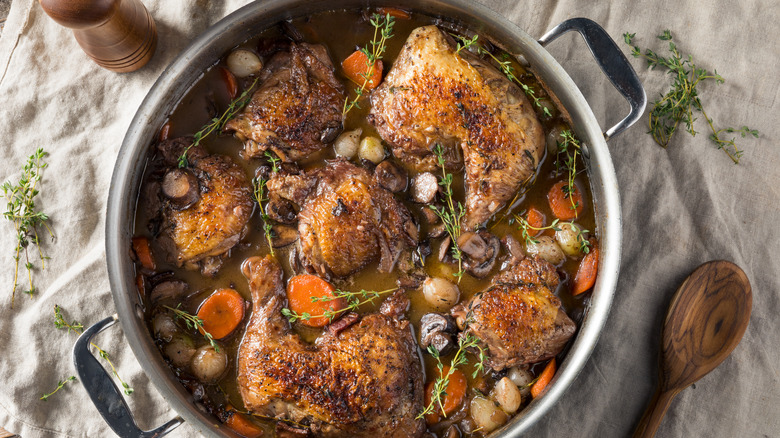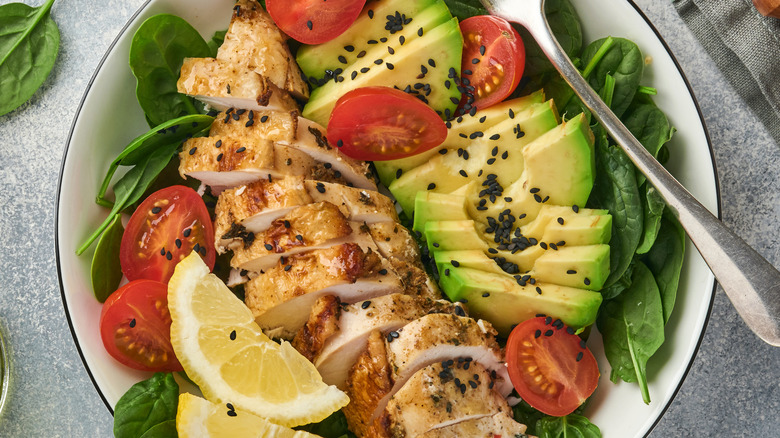Are Chicken Oysters Actually Poultry Or Seafood?
CORRECTION 2/6/23: A previous version of this article stated that chicken are mammals; Birds are not mammals.
If you're a fan of chicken, particularly roast chicken, then you may already know the answer to the question posed by the title. However, even the most studious of chicken carvers have the potential to miss these gems hidden beneath the surface. There are multiple cuts to a chicken. According to the Australian Chicken Meat Federation, you can get about 24 different cuts out of a single bird, skin on or off, including the giblets. The ones we're all familiar with, such as chicken breasts, legs, and wings, are certainly the most common and popular cuts of a chicken.
Chickens are a unique food category. They can be served whole and consumed in one sitting, which is more than you can say for a great many livestock animals. Imagine trying to down an entire cow for dinner. Not possible. Chicken can be a singular meal or broken apart into the aforementioned cuts and spread out across several different dishes. Regardless of how you use chicken, there is no doubting the miracle of the nutritious meat sitting before you.
There is, however, one cut that the ACMF doesn't mention. The federation can be forgiven, for this cut is something you have to hunt for. If you find it, you're in for a scrumptious flavor bomb that HuffPost calls the cook's favorite part of the chicken. They're called oysters, and no, they're definitely not seafood.
What are chicken oysters?
It is all well and good to state that the oysters are a cook's favorite part of the chicken, but ... what exactly are they? According to HuffPost, a chicken comes with two oysters. These tender little morsels are small, circular lobs of dark meat hidden beneath the skin in the cavity between the thigh joint and spine. This location is key to the oysters' popularity among cooks.
As they are located on the back of the bird, which is the side that sits in the pan during roasting, the oysters remain moist throughout cooking. The reason for this is twofold. Firstly, the oysters are protected by the chicken's skin, providing an added layer of protection against drying out. Secondly, they stay submerged in all the natural juices in the chick as it roasts (via Bell & Evans). So, the oysters are essentially braised, getting cooked while maintaining tenderness and retaining moisture. Chicken breasts, conversely, are sometimes finicky and can easily go dry with too much time in the oven.
According to Food52, there is a mildly selfish component when it comes to consuming chicken oysters. Very often, the cook takes the view of the oysters being a little present. A reward for cooking up a beautiful, succulent chicken, and taking the effort to carve it for the guests. So, you can think of sneaking off with the oysters as a little treat as another aspect of their appeal.
How to find chicken oysters
When it comes to carving a roasted chicken, you're going to begin in the standard way. Remove the legs and thighs by slicing through the connective joint holding the thighs to the backbone of the bird. Next, cut along the breastbone to remove the chicken breasts whole, leaving as little meat behind as possible. Remove the wings in the same manner as the legs by cutting through the joint. From here, you can continue to carve as you wish.
To find the oysters, we need to retrace our steps to when we removed the legs and thighs (via The Manual and YouTube). Flipping the chicken over, so that the breastbone now rests on the cutting surface, look to where the joint connected the thigh to the backbone. Remember, the oysters will be those two nuggets that appear between the thigh joint and spine. You can remove them simply by peeling back the skin and twisting them out of their cavity with your fingers.
If you're not up for cooking and deconstructing an entire chicken, it is possible to purchase oysters on their own. Though uncommon, there are certain brands that do sell oysters separately. You are, unfortunately, unlikely to find a package of oysters at the grocery store. But a company like JiDori might sell precut chicken oysters online.
What do chicken oysters taste like?
When asked to describe the taste of chicken, chances are people will talk about the white meat. According to MasterClass, the breasts are the single most popular cut of a chicken and are known for both their adaptability and flavor. The indicative pale color of the meat gave rise to the term "white meat" as referring to virtually all poultry and other milder meats, such as rabbit or veal.
A chicken's dark meat, on the other hand, is said to be more flavorful. The oysters, with their proximity to the thigh, are dark meat. According to The Manual, chicken oysters have the most concentrated roasted flavor of the whole bird. This is due to the fact that, as previously mentioned, the oysters remain submerged in the bird's juices during roasting.
The main difference between white and dark meat has to do with fat content and the percentage of red fibers. As MasterClass shows, dark meat has several more grams of fat and over double the amount of red fibers that white meat has. As the dark meat cooks, fat is rendered out of the meat and added to the cooking liquid. As the chicken rests once it is out of the oven, the remaining juices settle and provide the dark meat with its characteristic bold, juicy flavor.
Chicken oysters vs. other oysters
The chicken oyster is a small bomb of impactful flavor hidden beneath the surface of the bird, much like a true ocean oyster. The chief difference, obviously, is that one is derived from the meat of a land-dwelling bird, and the other is a sea-dwelling mollusk. Oysters, as the Chesapeake Bay Program points out, are filter feeders, prized for their flavor and abundance in both commercial fishing and aquaculture farming. They can be enjoyed raw in the half shell, roasted, or. grilled. Oysters can even be mixed with grits and tomatoes.
However, there is another meat-based oyster that is worth comparing to the chicken oyster. We're talking, of course, about Rocky Mountain Oysters. These so-called oysters — sliced portions of a bull's castrated testicles — are something of a legend of the American West (via Atlas Obscura). The oysters are battered and fried until golden and crispy and treated very much like french fries. Rocky Mountain Oysters come served with sides of either ketchup, hot sauce, or mayonnaise. The oysters came about as a byproduct of ranchers' control over the size of their cattle herds. Not wanting to waste protein — and Rocky Mountain Oysters are practically all protein — the ranchers created this flavorful, nutritious, slightly humorous, meal that came to be a definitive part of Western American culture.
How to cook chicken oysters
Like any cut of chicken, there are specific ways to cook the oyster in order to get the most out of it. As we've shown, the easiest way to cook oysters is as part of a whole roast. All you need to do is season the chicken, roast it, carve it, turn it over, and pick out the oysters. Easy peasy.
However, if you are looking for somewhat more involved, oyster-specific recipes, you can buy them separately from the rest of the chicken. Bell & Evans, which offers a pack of individual oysters at a Texas Market, recommends multiple different cooking methods for their product. Deep-fried, roasted, breaded, grilled, sautéed, or pan-fried are all excellent ways to cook oysters.
Like cooking a chicken thigh, or any other dark meat, the key is to lock in the naturally deep, fatty flavor. According to MasterClass, braising is an excellent method for cooking dark meat because the cooking juices help maintain moisture. You needn't be concerned about dry oysters, however. It is nearly impossible to overcook any dark meat because of the higher fat content and the fact that the muscles need longer to tenderize than white meat does. So, low and slow is likely your friend when it comes to chicken oysters.
Nutritional facts
According to Bell & Evans, one serving of chicken oysters is 4 ounces. Nutritionally, you are looking at 100 calories, 1 gram of fat, and 21 grams of protein. The cholesterol content hovers at 105 milligrams or 35%. A serving packs 80 milligrams of sodium. The cholesterol content might seem high. However, it is not the end of the world considering one is not likely to eat chicken oysters on a daily basis. Although buying them every Tuesday, like one of the characters from the charming French classic "Amélie," wouldn't be a terrible thing.
If you are following a low-cholesterol diet, you're not going to want to consume chicken oysters with regularity. Still, there are a sufficient amount of vitamins and nutrients in dark meat which could convince one to make it more of a special occasion. Richer in zinc, vitamins B-3, B-6, and C, and iron than white meat, dark meat has its share of health benefits (via MasterClass). If the chicken is raised free range, you may end up with a more nutritious meal as a result. Just be sure to do yourself a favor and hunt for the oysters the next time you do a full roast.
